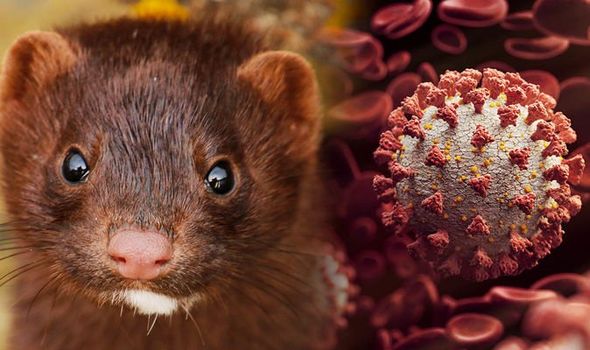SARS-CoV-2 Strains That Spread From Minks To Humans Had RBD Mutation Y453F And Were Resistant To At Least 4 Neutralizing Monoclonal Antibodies
Y453F Mutation: Japanese researchers from Kyoto Medical Center, Japan Science and Technology Agency (JST), Tohoku University School of Medicine and Kyoto University School of Medicine have in a new study of the SARS-CoV-2 virus strains that passed from infected minks to humans found that these strains contained the mutation Y453F on the receptor binding domain (RBD) of the spike glycoprotein and were found to escape detection by four neutralizing monoclonal antibodies that were used in the study, raising alarm that these mutation strains were potentially potent and extreme;y dangerous to humans.

The study findings were published on a preprint server and are currently being peer reviewed.
https://www.biorxiv.org/content/10.1101/2020.11.27.401893v1
Natural selection “adaptation” in the coronavirus can occur during coronavirus amplification in vivo in farmed minks. Natural selection in such viruses is observed by introduction of mutations in SARSCoV-2 that are not observed during the growth process in humans. Infection with a mutant (Y453F) of SARS-CoV-2 from farmed minks is known to widely spread among humans.
https://pubmed.ncbi.nlm.nih.gov/33188367/
The study team investigated the virological characteristics of this SARS-CoV-2 mutant (Y453F) using three-dimensional protein structural analysis.
This experimental study suggests that virus variants with the Y453F mutation partially escaped detection by four neutralizing monoclonal antibodies. The spread of SARS-CoV-2 variants mediated by millions of infected farmed minks is uncontrolled; consequently, raising a concern that infection of SARS-CoV-2 mutants that cause serious symptoms in humans may spread globally
These new SARS-CoV-2 mutants had an amino acid mutation Y453F in the sequence encoding spike glycoprotein. This SARS-CoV-2 mutant has been detected in approximately 300 viral sequences isolated from the European and Dutch population as well as in minks. Data on the three-dimensional structure of the receptor binding domain (RBD) of the spike glycoprotein of SARS-CoV-2 (PDB ENTITY SEQ 6VW1_1) was used in these studies.
https://www.nature.com/articles/s41586-020-2179-y
Data (PDB: 6XC2, 6XC4, 7JMP, 7JMO, 6XKQ, and 6XKP) on the three-dimensional structure of six neutralizing antibodies (CC12.1, CC12.3, COVA2-39, COVA2-04, CV07-250, and CV07-270) that bind to the spike glycoprotein of SARS-CoV-2 was used in these studies.
https://science.sciencemag.org/content/369/6507/1119
Utilizing the Spanner program, the study team predicted the three-dimensional structure of the SARS-CoV-2 spike glycoprotein Y453F mutant based on PDB (ENTITY SEQ 6VW1_1).
The team investigated the binding of the spike glycoprotein Y453F mutant of SARS-CoV-2 to human angiotensin-converting enzyme 2 (ACE2) and determined the affinity of the spike glycoprotein Y453F mutant of SARS-CoV-2 to six neutralizing monoclonal antibodies using the MOE program.
The study findings showed that the Y453
F mutation did not affect the three-dimensional structure of conventional SARS-CoV-2 spike glycoproteins. From the present study, it was clarified that the binding property of the spike glycoprotein Y453F mutant to human ACE2 was slightly weaker than that of the conventional SARSCoV-2 spike glycoprotein. This was due to the replacement of Tyr at position 453 by Phe, which was unable to form a hydrogen bond with His at position 34 in human ACE2.
The findings revealed that the affinity between the spike glycoprotein Y453F mutant and four of the six monoclonal antibodies (CC12.1, CC12.3, COVA2-39, COVA2-04, CV07-250, CV07-270) examined was clearly weak compared with the conventional SARS-CoV-2 spike glycoprotein. It is considered that the affinity between the appropriate amino acid residues in the variable region of the antibody and the spike glycoprotein Y453F mutant was diminished owing to weak recognition of the monoclonal antibody to spike glycoproteins.
The study team said that mutations in SARS-CoV-2 that lead to generation of SARS-CoV-2 subspecies, have made humans and animals susceptible to infection through easy propagation in the host, thereby making it difficult to identify the effects of therapeutic agents or vaccines for COVID-19. Moreover, the spread of SARS-CoV-2 variants mediated by millions of infected farmed mink is uncontrolled; consequently, raising a concern that infection of SARS-CoV-2 mutants that cause serious symptoms in humans may spread globally.
This study along with many others contradicts a recent British study involving European researchers that were most probably ‘bought’ by the vaccine developers to come up with a ‘half baked’ stupid manipulated study that said that all of the current SARS-CoV-2 mutations are neither more infectious nor more dangerous. Various Western media without any once of credibility were lapping up these study results. Fortunately Britain is one of the most badly affected countries and has a high COVID-19 death rate and hopefully these rates will keep rising due to their arrogance and stupidity.
For more on the
Y453F Mutation, keep on logging to Thailand Medical News.
HELP! Please help support this website by kindly making a donation to sustain this website and also all in all our initiatives to propel further research: https://www.thailandmedical.news/p/sponsorship
